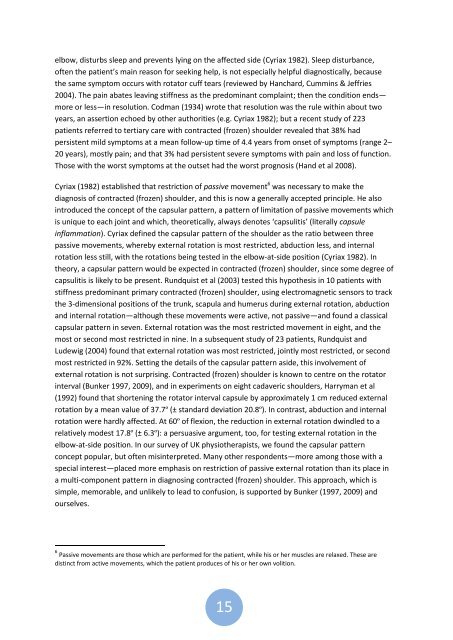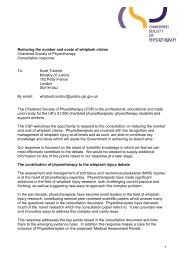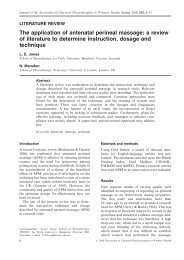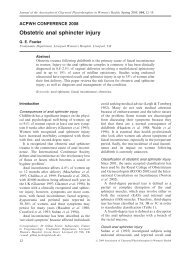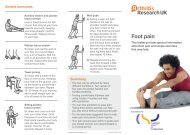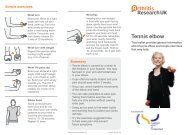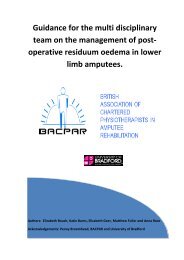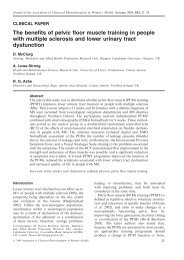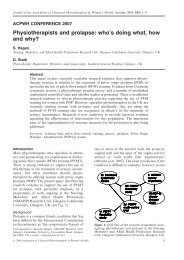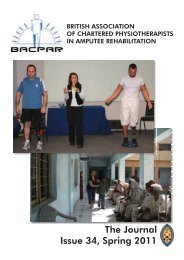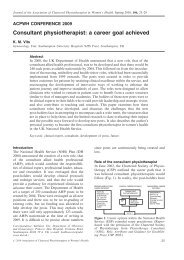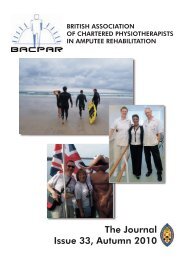here - The Chartered Society of Physiotherapy
here - The Chartered Society of Physiotherapy
here - The Chartered Society of Physiotherapy
Create successful ePaper yourself
Turn your PDF publications into a flip-book with our unique Google optimized e-Paper software.
elbow, disturbs sleep and prevents lying on the affected side (Cyriax 1982). Sleep disturbance,<br />
<strong>of</strong>ten the patient’s main reason for seeking help, is not especially helpful diagnostically, because<br />
the same symptom occurs with rotator cuff tears (reviewed by Hanchard, Cummins & Jeffries<br />
2004). <strong>The</strong> pain abates leaving stiffness as the predominant complaint; then the condition ends—<br />
more or less—in resolution. Codman (1934) wrote that resolution was the rule within about two<br />
years, an assertion echoed by other authorities (e.g. Cyriax 1982); but a recent study <strong>of</strong> 223<br />
patients referred to tertiary care with contracted (frozen) shoulder revealed that 38% had<br />
persistent mild symptoms at a mean follow-up time <strong>of</strong> 4.4 years from onset <strong>of</strong> symptoms (range 2–<br />
20 years), mostly pain; and that 3% had persistent severe symptoms with pain and loss <strong>of</strong> function.<br />
Those with the worst symptoms at the outset had the worst prognosis (Hand et al 2008).<br />
Cyriax (1982) established that restriction <strong>of</strong> passive movement 6 was necessary to make the<br />
diagnosis <strong>of</strong> contracted (frozen) shoulder, and this is now a generally accepted principle. He also<br />
introduced the concept <strong>of</strong> the capsular pattern, a pattern <strong>of</strong> limitation <strong>of</strong> passive movements which<br />
is unique to each joint and which, theoretically, always denotes ‘capsulitis’ (literally capsule<br />
inflammation). Cyriax defined the capsular pattern <strong>of</strong> the shoulder as the ratio between three<br />
passive movements, w<strong>here</strong>by external rotation is most restricted, abduction less, and internal<br />
rotation less still, with the rotations being tested in the elbow-at-side position (Cyriax 1982). In<br />
theory, a capsular pattern would be expected in contracted (frozen) shoulder, since some degree <strong>of</strong><br />
capsulitis is likely to be present. Rundquist et al (2003) tested this hypothesis in 10 patients with<br />
stiffness predominant primary contracted (frozen) shoulder, using electromagnetic sensors to track<br />
the 3-dimensional positions <strong>of</strong> the trunk, scapula and humerus during external rotation, abduction<br />
and internal rotation—although these movements were active, not passive—and found a classical<br />
capsular pattern in seven. External rotation was the most restricted movement in eight, and the<br />
most or second most restricted in nine. In a subsequent study <strong>of</strong> 23 patients, Rundquist and<br />
Ludewig (2004) found that external rotation was most restricted, jointly most restricted, or second<br />
most restricted in 92%. Setting the details <strong>of</strong> the capsular pattern aside, this involvement <strong>of</strong><br />
external rotation is not surprising. Contracted (frozen) shoulder is known to centre on the rotator<br />
interval (Bunker 1997, 2009), and in experiments on eight cadaveric shoulders, Harryman et al<br />
(1992) found that shortening the rotator interval capsule by approximately 1 cm reduced external<br />
rotation by a mean value <strong>of</strong> 37.7º (± standard deviation 20.8º). In contrast, abduction and internal<br />
rotation were hardly affected. At 60º <strong>of</strong> flexion, the reduction in external rotation dwindled to a<br />
relatively modest 17.8º (± 6.3º): a persuasive argument, too, for testing external rotation in the<br />
elbow-at-side position. In our survey <strong>of</strong> UK physiotherapists, we found the capsular pattern<br />
concept popular, but <strong>of</strong>ten misinterpreted. Many other respondents—more among those with a<br />
special interest—placed more emphasis on restriction <strong>of</strong> passive external rotation than its place in<br />
a multi-component pattern in diagnosing contracted (frozen) shoulder. This approach, which is<br />
simple, memorable, and unlikely to lead to confusion, is supported by Bunker (1997, 2009) and<br />
ourselves.<br />
6 Passive movements are those which are performed for the patient, while his or her muscles are relaxed. <strong>The</strong>se are<br />
distinct from active movements, which the patient produces <strong>of</strong> his or her own volition.<br />
15


